by Paul Howard (NCTCUG)
The opinions reflected in this column are those of the curmudgeon behind the keyboard, and not those of the editor or NCTCUG
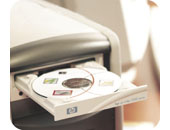 Back in July I filled another drive bay of my computer with an HP 9100 CD Writer Plus, with speed ratings of 8x - 4x - 32x. Like many things these days, I’ve not really found the time to really put it through its paces - in truth, I’m not sure I know what its paces should be! The thought of waiting for often-bootlegged music files to download from the Internet at 3 megs per song doesn’t appeal, although I have listened to some MP3 selections on a computer club’s CD of shareware that have amazing fidelity. Some of the selections, which I was really beginning to enjoy, suffered from apparent “network congestion” or similar effects. At least, to me, they sounded like some of the problems I’ve experience while listening to radio stations on the net broadcasting via RealAudio.
Back in July I filled another drive bay of my computer with an HP 9100 CD Writer Plus, with speed ratings of 8x - 4x - 32x. Like many things these days, I’ve not really found the time to really put it through its paces - in truth, I’m not sure I know what its paces should be! The thought of waiting for often-bootlegged music files to download from the Internet at 3 megs per song doesn’t appeal, although I have listened to some MP3 selections on a computer club’s CD of shareware that have amazing fidelity. Some of the selections, which I was really beginning to enjoy, suffered from apparent “network congestion” or similar effects. At least, to me, they sounded like some of the problems I’ve experience while listening to radio stations on the net broadcasting via RealAudio.The Cambridge Soundworks speakers I bought last year are really the key to a “hifi” listening experience. The same CD has a wide range of midi files, and several of those are amazingly good. Several of them emulate a jazz trio of piano, bass, and percussion, and you’d swear you were in a smoky jazz club (sans clinking glasses!) For a sample, listen to the midi selection on the Links page of the NCTCUG web site. If it sounds very “piano-like” you’ll know you’ve got a good sound card, midi software, and speakers.
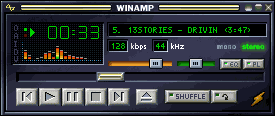 I bought a “Dummies” book on MP3 music some months ago when someone pointed out a series of bargains at Office Depot during a computer club meeting - I’ll have to dust it off and find out what MP3 is really all about. I suppose if you have kids in the house, you’ve got the MP3 scene covered - experts at the ready. For me, I’ve got to practically get out the magnifying glass to read the labels on the controls of the WinAmp MP3 software player. Has anyone found the “old farts” button? You know, the one to blow up the on-screen image big enough so us bifocal wearers can figure out which button to click to advance to the next song?
I bought a “Dummies” book on MP3 music some months ago when someone pointed out a series of bargains at Office Depot during a computer club meeting - I’ll have to dust it off and find out what MP3 is really all about. I suppose if you have kids in the house, you’ve got the MP3 scene covered - experts at the ready. For me, I’ve got to practically get out the magnifying glass to read the labels on the controls of the WinAmp MP3 software player. Has anyone found the “old farts” button? You know, the one to blow up the on-screen image big enough so us bifocal wearers can figure out which button to click to advance to the next song?NCTCUG will be exchanging newsletter meeting announcements with WACUG, the Washington Area Commodore User Group. They generally use “Computer” as their middle name - like our “Tandy” group, supporting more than the now orphaned systems we were founded on. JJ Davis brought WACUG to our attention earlier this year, and I’ve attended several of their monthly meetings. WAC meets in the afternoon of the third Saturday of the month in the Fairfax County Government Center, near Fair Oaks Mall. Recent topics have included demos of Win 98's feature of driving two monitors from a single computer (think really wide spreadsheet, or the output of two programs without having to toggle between them), Linux programs, fighting email spam and Internet privacy, and an excellent demo by Micro$oft’s Debby Pfundstein of Windows ME.
Rant Department
I guess Halloween must trigger a hacker gene, prompting certain folks to move to the dark side. Press coverage reported that Micro$oft involved the FBI in an intrusion into the company’s systems storing future projects, apparently involving their new “software on the web” venture. The bad guys slipped in a “trojan horse” program with an email to a company employee, that then sent back user IDs and passwords to the hackers. I wonder if having all those short haircuts and suits of the feebies around will “stifle innovation” in Redmond?
I’m the first to admit it - I don’t understand why anyone would want to use software applications residing on the net rather than on their “personal” computers. Remember the “PC” - that was the nifty box that freed us from the tyranny of the corporate Information Systems departments, with their mainframes, arcane jargon, and memos that said we couldn’t get any changes to the software and reports needed to do our jobs, because our request was evaluated at needing 3.7 person years of effort?
Now we should use the Internet as a conduit to prepare our marketing plans and financial strategies? Don’t worry, your private and proprietary information will be protected by a 2048 bit encryption scheme, which will only add modestly to overhead. Translation: Your spreadsheet will run like full screen, full motion video over a 300 baud modem, and will be absolutely secure. Yeah, until all the 7th grade script kiddies at Patrick Henry Middle School link their computers via cable modem, break the encryption scheme, and send your retirement savings to an offshore bank account in the Lesser Antilles, on which they’ll write checks to buy games for their Play Station II. (Hyperbole is a wonderful thing!)
Micro$oft made a large investment in Corel, to the north of $100 million, with press releases touting the co-operation of the companies on the M$ Internet software initiative. Putting on my conspiracy hat - could the “evil empire” be planting the final seeds of destruction for the company that produces WordPerfect, and offers a variety of Linux, and Linux versions of Word Perfect and other software? And when I tried to go to the Corel web site this morning to check the official press release about that investment for this column - their server was down.
Hackers also got into Drudge Report - my wife starts with Drudge in her search for news - the site has links to many news providers and a wide range of columnists. Friday night she gave a little shriek - a porn site had replace the fare normally dispensed at the Drudge site. Probably the guys from the Washington Post and NY Times that Drudge has beaten to a story decided to get even!
By Paul Howard (NCTCUG)
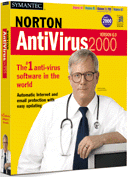 Norton AV Upgrade
Norton AV UpgradeSome months ago, my wife’s computer announced that it couldn’t update its anti-virus protection. Actually, Symantec (Norton Antivirus Version 2.0) wanted a few bucks for a year’s subscription to the virus definition updates, which after several years of free update service, seemed reasonable. One thing led to another, and we hadn’t gotten ‘round ‘tuit yet. A CompUSA supplement reminded us, and we decided to buy a new version. Unfortunately, contrary to the ad in the paper, we weren’t able to take advantage of part of the rebate program, because the coupon in the box had expired a month previously. Curses!
The challenge came when I tried to install the software. This computer is a 90 MHz Pentium, with 48 megs of memory, and two hard drives, a one gig, and 2.5 gig. Difficulty with the C: drive - no room for the files that needed to be added for the new program in the Windows system directory. This computer was purchased when a 250 meg partition for the C drive seemed more than adequate - “Those were the days, my friends...”
What to do with insufficient space on the C: drive - reach for PowerQuest’s Partition Magic, naturally! I loaded Partition Magic from a CD onto a partition in the second drive - while this version of PM is graphical, I expect it’s a DOS application - ‘cause it didn’t need to write anything on the C: drive. And in the course of things, I created a Partition Magic “Rescue” disk.
I went to work on the first drive, carving out free space on the E:, F: and G: partitions (with two hard disks, the first partition on the second drive becomes D:) moving all the free space to the front of the E: partition. Then came the bump in the road. There were problems with the integrity of some of the files and directory entries, so that the Partition Magic program wouldn’t complete the incorporation of the free space into C:. I had to run Scan Disk to fix the allocation tables. Then when I went back to try and run Partition Magic, it wouldn’t start. The only good news in this bout was that I’d made the rescue disk. I was able to run the command line version of PM from the Rescue floppy, and that completed the process of moving the free space into the C: partition. Needless to say, the 10 minute software upgrade is now approaching two hours. Memo to brain - next time, run Norton Disk Doctor / Scan Disk and Speed Disk / Defrag before attempting a Partition Magic session!
I finally loaded Norton AV 2000, version 6 on the computer, connected to the internet for the latest virus definitions and was now in business... well, almost. The initial virus scan took five and a half hours!. I’ve gone into the StartUp folder (under Windows, Start Menu, Programs), and pulled some old programs out that didn’t need to be there, which seems to have speeded things up - cut an hour and a half off the process.
I checked Norton’s web site, but haven’t found any directly applicable clues. I asked for suggestions at a recent computer group meeting, and the consensus seemed to be that it’s a function of a bigger program and the ever expanding list of virus signatures the program’s got to check. Now I’m inclined to think that the computer may be memory bound - insufficient memory for the task at hand, and too much swapping to disk. Think I’ll hit the next computer show and add some memory. This presumes I can talk my wife into it - she’s convinced that every time I tinker with her computer, she encounters more glitches. Tune in again next time....
‘There’s Always a Reason’ Department
The morning after completing my column, and emailing it to our editor, I received an email message from Symantec: “In the past, AntiVirus programs only scanned executable files. However, virus writers discovered that they could rename certain infected files to escape virus detection. In response, Norton AntiVirus began to scan all files by default, rather than just program files. The problem with this new strategy is that scanning all files required more computer resources and could at times slow down other applications. Smart Scan is designed to first scan all files to see if they are capable of being infected with a virus. Then, Smart Scan scans only those files that are capable of carrying a virus infection. In this manner Norton AntiVirus 2001 offers the same level of virus protection and uses less computer resources.”
SPAM
Unsolicited email seems to be a major topic of conversation at every computer group meeting these days. Most folks seem to suggest that sending a message to the “opt out” address will only guarantee more of the endless stream of get rich quick schemes, casino ads, and proclivity of the month enticements. A good place to start in your search for solutions is http://www.cauce.com and follow links to sites that will help you battle this plague.
Some suggestions I’ve heard that make sense include using an address from one of the free webmail services every time you sign up for something on the web, rather than using the address you really want to use for your important email. You can check the web mail address less frequently, and see if it’s filling up with spam - good sign one of those web sites you signed up with is selling addresses. You might even set up a separate web mail account for every time you submit an email address. Then you’d be like our friend who puts apartment numbers on every bingo or warrantee card he sends in, and keeps track of what number went where. The USPS snail mail carrier is still trying to figure how this 2000 sq. ft. rambler is divided into 417 apartments <grin>!
After listening to a variety of complaints and suggested solutions, I decided to try the filtering capabilities included with current versions of Netscape’s Messenger email client. I know one of Eudora’s selling points for years has been its filtering features - I’ve not used the Eudora program for several years, so I can’t comment based on actual experience. The need I had for creating mailing lists for various organizations using Eudora evaporated as Netscape’s mail client expanded its functionality. And, once again, after the completion of my column, I received an Email from Qualcomm, announcing the availability of an upgrade to Eudora.. The 5.0 version of the program is available in a ‘Lite’, Paid, or Sponsored mode. The sponsored mode has all the features of paid edition, but has an ad window in a corner of the screen display. Learn more at: http://www.eudora.com/email/index.html
I did decide to try Netscape’s mail filtering, and I’ve been fairly successful. From the Messenger window, select Edit, Filters and proceed to build a series of conditions for “rejecting” mail - sending it all to a folder - create one called “possible SPAM” - then sit back and see what accumulates. I noticed that much of my spam was coming from domains other than .net, .org, and .com, so I established one of the filters to send everything to the “poss SPAM” folder that comes from domains other than those, plus .mil and .gov.
I’ve also got to find a way to keep .edu from being sent to the spam box - but I don’t get many from edu domains. I know, I’ll set another filter to send everything from .edu domains to the inbox before the other domain filters are applied! I’ve also set up filters with some of the body text from some of the “get rich” schemes I seem to get several of each day, so they go to the “dumper” folder as well.
| The opinions reflected in this column are those of the curmudgeon behind the keyboard, and not those of the editor or NCTCUG. |
by Paul Howard
What’s the old line? “To save your teeth, open mouth fully before inserting foot.” Seems I spoke too soon when I mentioned in my last column that sending an email message to Windows Magazine didn’t seem to work. The publication shifted from print to Internet based, and I was left with two years to run on my subscription. Windows Magazine was published by CMP Media, and while they publish at least a dozen IT (information technology) magazines, none are really of the “PC general interest” variety, which is what I’ve been looking to replace the Windows subscription. I decided to seek a refund rather than select another publication from their stable. Bill Higgins had been successful on the same quest via snail mail, but I figured any mag that had abandoned print for the web should work in Internet time.
Back on February 6th, I sent my email refund request to the Customer Service address at: http://www.winmag.com. On June 14th, I received a refund check for $49.90. Interestingly, it was dated March 31st. So, I take it back - Windows Magazine does respond to its email, but on “Pony Express” time! Oh, and the check says”Void 90 days after check date.” So, it’s like many current computer software refund offers. You’d better complete the coupons, clip the ‘proof of purchase’ seal, and mail everything in as soon as you get home from the store, or “Sorry, Charlie, you missed the 10 day window for requesting the refund!” I think I’d better cash that check this afternoon.
Well, Judge Jackson of the US District Court in DC has ruled, finding Micro$oft ‘Guilty’ and ruling the company should be broken up in two pieces. Based on the press coverage, spin and hype, I’m waiting for the Pyramids to sink below the sands of Egypt, and the head of the Sphinx to follow his nose into oblivion. Yes, friends, the end of the world is clearly at hand. Steve Ballmer, BillyG’s attack dog CEO, was on the PBS News Hour Wednesday evening, assuring everyone he has the utmost respect for the law, whilst singing the old blues standard, “Dat judge, he done done us wrong!” Da Da, Da Dum, Da Dum, Da Dum. Da Da, Da Dum, Da Dum, Da Dum. My, oh my - Muddy Waters, where are you, now that we need you?
Why, there’s some great reasons out there for not taking a chance and “hurting” Micro$oft - the stock price has gone from $130 to $70 in the last year. It’s one of the most widely held stocks, it’s in lots of retirement portfolios - we wouldn’t want to punish stockholders, would we? Hey, it’s the stock market, stupid! Place your bets, ladies and gentlemen. What, you thought this was WWF Smackdown, where the winner of every contest is known in advance?
If a drug company’s latest blue pill to grow hair on your noodle turned your liver to noodles instead, would we expect the government to stand idly by, and not order it off the market, for fear of hurting the company’s stock price?
Fortune Magazine coverage of Microsoft
Microsoft's web site devoted to the Anti-trust Trial: Transcripts, Judgements, Findings of Fact, press releases.
| The opinions reflected in this column are those of the curmudgeon behind the keyboard, and not those of the editor or NCTCUG. |
by Paul Howard
And it’s time! Any doubts you may have had that we’re in a “throw-away” society can safely be dispelled in the demise of an area institution. On May 31st, in a strip mall at Bailey’s Crossroads about two blocks from Don Gruenther’s house, the Electric Shaver Shop will close its doors forever. These folks have dedicated themselves for 39 years to fixing electric razors, beard, moustache, and hair clippers. They also sold these items, and travel voltage converters, hair dryers, and parts and accessories for coffee makers made by some of manufacturers of the shaving implements.
So, if your favorite electric razor just doesn’t do the job ‘cause it needs new blades, or new brushes for the motor - faggedaboudit - unless you can get there before the 31st! Same with all the battery operated units - all will be pitched when they won’t take a charge - because where can you go to get them repaired?
Just another symptom - as a general rule, most consumer electronics don’t get repaired anymore. Unless it’s a pricey home theater system, it’s probably lasted ten years, so we just pitch it and get a new one. I should talk - the Heathkit 14" TV I built from a kit in ‘73 is sitting in pieces in the basement - just can’t seem to find the ‘round tuit - TIME - to troubleshoot it. It should be an easy problem - seems to be power supply related, probably a shorted rectifier diode or bad filter capacitor. But I can’t seem to find the time - won’t mention that my oscilloscope’s also not working - which would be a major help in most troubleshooting. Then, stacked behind the Heathkit, is a 19" RCA TV, and on it goes - more projects than time.
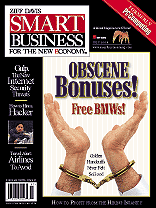 Starting last summer, that ultimate censor, filthy lucre, started once again to infringe on my right to read what I wanted. Windows Magazine pulled the plug on the readily portable, reading room edition, i.e. print version of the publication, and became another webzine. Then PC Computing changed its orientation, moving away from a general interest computer publication to a internet business rag. This month, the transition completed itself, as the publication changed its name to “Ziff Davis Smart Business for the New Economy.”
Starting last summer, that ultimate censor, filthy lucre, started once again to infringe on my right to read what I wanted. Windows Magazine pulled the plug on the readily portable, reading room edition, i.e. print version of the publication, and became another webzine. Then PC Computing changed its orientation, moving away from a general interest computer publication to a internet business rag. This month, the transition completed itself, as the publication changed its name to “Ziff Davis Smart Business for the New Economy.”I suppose it’s all my fault. About a year ago, suffering from sliding piles of magazines on every flat surface in the house - tables, night stand, bathroom vanity, hassock, floor, and file cabinet - I just took a breather. I let some subscriptions expire, just so I could catch up and try to sort out the shambles of our home. Thus stopped Money Magazine, which I’d been using for mutual fund information since the early ‘90s; Fortune, my source for business information since about 1975; and Electronics Now, formerly Radio Electronics to which I had a subscription since 1971.
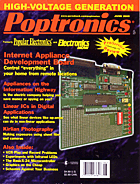 Clearly, the publishers of everything I read, noting the fact that I’d let these long term subscriptions lapse (and preceded in termination by Time Magazine, to which I’d subscribed since about 1966) decided to fold or change their editorial direction because of my fickleness. With the New Year, Gernsback Publications crunched Electronics Now and Popular Electronics into Poptronics. Soon, there’ll be nothing left to read, unless you do it on the web. I find it extremely inconvenient to balance a keyboard and 17" monitor on my lap every morning when I - oh, never mind !!
Clearly, the publishers of everything I read, noting the fact that I’d let these long term subscriptions lapse (and preceded in termination by Time Magazine, to which I’d subscribed since about 1966) decided to fold or change their editorial direction because of my fickleness. With the New Year, Gernsback Publications crunched Electronics Now and Popular Electronics into Poptronics. Soon, there’ll be nothing left to read, unless you do it on the web. I find it extremely inconvenient to balance a keyboard and 17" monitor on my lap every morning when I - oh, never mind !!Perhaps interestingly, these new forms of journalism aren’t really in tune with their direction after all. I’ve attempted correspondence over the web with Windows Mag and PC Computing before its transmutation to Ziff Davis Smart Business for the New Economy. I was attempting to get a refund from both publications, since Windows packed up with two years left to run on my subscription, and I really wasn’t interested in a magazine that was screaming at me that “I was going to be toast unless I transmuted myself to a 24 year old, moved my entire life to the web, and brought my pets to work!!” Neither magazine has responded to email communication, but Bill Higgins got a refund from Windows via a snail mail communication. So, “where’s the beef?”
I picked up a copy of Fortune in December, which contained an article reiterating the basics of investing, based on various speeches and interviews with Warren Buffett - yeah, that one - chair of Berkshire Hathaway, with the $60K per share stock price. Yup, I know they’ve had a slide this year, but I don’t think the Internet is so revolutionary that it will kill all the old rules about why good investments are good investments. Commenting on the dot coms at this weekend shareholder’s meeting, Buffett referred to them as “speculative” and that what’s driving them is “wealth transfer” rather than “wealth creation.” And the Buffett quote most notable on the hazardous nature of investing in internet stocks, “If you mix raisins with turds, they’re still turds.”
I’ve been in the company of a lot of folks lately that think it’s terrible that the government’s after Microsoft. Their view seems to be, in part, that it’s all jealousy over Bill’s billions and failure to make campaign contributions. For years some of my computer friends have sworn that many of the computer magazines have gone easy on Microsoft, and certainly many of these publications have held similar positions on the perfidy of the government in pursuing the antitrust action. Surprisingly then, Ziff Davis Smart Business for the New Economy carries an article “Doing Business the Microsoft Way” that mentions an antitrust suit by Caldera, the holder of the rights to DR-DOS, settled confidentially for a reported $600 million, and the Stac Electronics patent infringement case, which Microsoft eventually settled for $83 million.
So, s’plain to me why Microsoft isn’t a business bully, and shouldn’t be held accountable. I’d contend if they were a street punk, they’d be a three time loser, and headed for the “big house” for life. Here’s how I get there: Stac patent infringement suit - strike one; labor law / employment case - all those independent contractors that should have been employees - strike two; now, antitrust violation, hey man, that’s strike three - if you do the crime, ya gotta do the time!
I think I know what it’s like to get picked on by the government - my employer had to suck it up in 1982, and settle an ongoing antitrust case that broke up AT&T and the Bell System. It makes you feel sick when the outfit you’ve hitched your wagon to for a (hopefully) long and fruitful career acknowledges wrongdoing and accepts fracturing the business into eight pieces (seven Baby Bell, plus AT&T.) It’s really confusing when you know you work for a regulated monopoly and you’re accused of acting like a monopoly. Well, duuhh. Hey, why should splitting up Microsoft be cataclysmic - they only employ 25,000 people, vs. a million gainfully employed in the old AT&T? Oh, I forgot - you’ve got to treat tech millionaires, like sports millionaires, special. We should look the other way when they break the law, right?
All this probably comes about because the Microsoftians listened to their lawyers, “Don’t worry, we can get you out of any trouble you get into.” Kaching, kaching goes the legal fee cash register. Now, they can’t acknowledge wrongdoing if they wanted to - that would let their insurance companies, who’re now on the hook under a variety of business insurance policies, dodge the bullet to pay off some of the wronged parties. And you know what happens when your insurance company loses money - bet my car and homeowners policies cost more next year!
by Paul Howard (NCTCUG)
 Norton Anti-Virus Definitions
Norton Anti-Virus DefinitionsI got a surprise when I went to update my Norton Antivirus definitions on Friday evening. Back came a message that my subscription was expiring in sixty days, and I’d need to purchase a new one to continue getting the updates. Starting in April ‘98, with Norton AV 4.05, the purchase of Symantec’s retail antivirus product included a one-year subscription to updated virus definitions, which can be downloaded from their web site. New definition files are available weekly, and sometimes almost daily when dangerous viruses are encountered. Norton SystemWorks includes a six month subscrition to Norton Web Services, which includes the virus definitions.
 The subscription for virus definitions is certainly reasonable, at $3.95 for a year. Product versions earlier than Norton AV 4.05 apparently have perpetual updating included. Norton Web Services, which provides an updating service for a vast variety of software, hardware drivers, etc. costs 3.95 a month, or 29.95 a year, after the initial six months service that comes with the package.
The subscription for virus definitions is certainly reasonable, at $3.95 for a year. Product versions earlier than Norton AV 4.05 apparently have perpetual updating included. Norton Web Services, which provides an updating service for a vast variety of software, hardware drivers, etc. costs 3.95 a month, or 29.95 a year, after the initial six months service that comes with the package.Of course, the retail versions of Symnatec products are generally available at steep discounts - often half price, and this time of year are regularly part of “bundle” deals with tax software, particularly Turbotax products from Intuit. I was planning to check out a deal at Staples that seemed to offer a combination of about four packages from Intuit and Symantec for a total of $30 after all the rebates. The trick with most of these is to mail in the rebate coupon on the day you buy the software, because chances are it’s a very time-limited offer - ask me how I know <grin>! In short, if you’re a regular upgrader of Norton Anti-virus or System Works, you might never see your virus definition subscription expire if you’re constantly buying new versions of the base software.
Hardware Turmoil
While we intended to view the 2nd half of Bill Gates’ speech at Fall Comdex at February’s General meeting, we spent the evening working on and talking about a variety of hardware problems. At Roger Fujii’s sugestion, Jim Rhodes had picked up a new sound card (Ensoniq - a division of Creative Labs) for the club’s demo computer. The one we’ve used for several years conflicted with our current modem card, so we couldn’t get any sound functions to work. Dean Mires installed the new card, after removing as many remnants of old sound drivers and programs as he could find. Of course, there’s still one driver buried in a hidden corner of the hard drive, so the computer stops with a terrifying blue screen during the boot process. However, bashing <enter> takes us past that, the computer completes bootup, and now both new sound card and modem work.
Another project was Don Gruenther’s computer, on which one printer port stopped functioning. Don had added an HP Photosmart P1000 on LPT2, then added an HP 5200C scanner. Both would work separately, but the combination, where the scanner is first in the chain from the LPT port, then the printer plugs into the scanner, didn’t work, and experiments with a variety of cables didn’t help. Eventually, the port wouldn’t work with anything, and wasn’t displayed in Window’s device manager. Jim Rhodes went home, brought back and plugged in a new parallel port card, which would now display appropriately in Device Manager. Don still can’t get the scanner printer combination to work, although the port will drive a stand-alone printer. I had some initial difficulties when I installed a DTC parallel card in my computer as a second LPT port for a similar scanner / printer combination. I had to tweak my BIOS setup to “EPP” mode for the parallel ports. The other modes wouldn’t work with this combination of hardware, which uses a software based, parallel port SCSI interface for the scanner.
Don was also experiencing difficulty with his CDROM drive, which was not reading some disks. Jim trotted home again, and brought back another CD drive, which solved that problem. We kidded Jim about being the newest computer “screwdriver shop” in Arlington, having all these parts on hand, and he confessed to having five systems currently occupying his work area!
Bill Higgins reported success in finally getting a second floppy drive installed in his Gateway Pentium 350 computer. This effort occupied some time at one of our meetings, and an all-nighter by Bill and Dean Mires. Bill’s son got a BIOS upgrade for the computer from Bios manufacturer Phoenix, did the Flash upgrade, and the computer now has both 3.5 and 5.25 inch drives. Bill was trying to recover data from 5.25" floppies. I still can’t believe a manufacturer would ship a computer that wouldn’t allow a second floppy to be installed. Granted, the use of floppies is getting almost superceded by CDROM drives and network / Internet connections, but to ship a system with crippled BIOS seems really shortsighted.
Bill also sought help about a monitor problem. Gateway had shipped Bill a new monitor under warranty when the old monitor died, but it intermittantly shuts down from a frequency mismatch between the video card and monitor. Dean Mires offered techniques to overcome the system’s “Plug and Pray” features for the monitor.
Mel Sacks reported error messages from a Lotus spreadsheet, for which Dean Mires made some suggestions for possible solutions. Mel also show us a map of the Carlin Hall area he’d printed from a Microsoft product in his search for a better route to the meeting place from his home in Maryland. Most noticeable was the piece of Carlin Springs Road that connects to Glebe Road, missing from the map as we tried to explain to Mel how to get to the Pizza SIG following the meeting. If you’re thinking of coming to your first Pizza SIG, check the map and directions on the club web site: http://lookhere.com/nctcug/pzaroute.html
KEEPING UP (February 2000 NL)
by Paul Howard (NCTCUG)
YME2K?
Guess you could say I'm a "stick in the mud" because I rarely stay awake for New Year's celebrations. This year, I had to see what would happen to our computers. My newest worked flawlessly (so far). Our four and a half year old Pentium 90 turned to January 4, 1980. Our other computer, still running Windows 3.1 (AMD 5X86 / 133) didn't make the transition properly either. Both these machines seemed ok after changing the date to the correct one, turning them off, then on again - January 1, 2000 all around. Now what I want to see is full length TV specials of the fireworks in cities around the world - from those I did see, the Eiffel Tower display in Paris was the best.
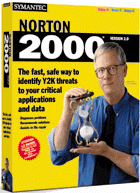
Actually, the Pentium 90 consumed a couple of hours of pain early evening - we ran Norton 2000 and the computer reported the date change problem, and said that the "2000" program would install a memory resident module to overcome that. Well, Linda and I rebooted a bunch of times, used "Live Update" twice to get the latest program information - with a first attempt error message that the update couldn't be installed. When we tried to go to the Symantec / Norton web site for the free upgrade from Version 1 to Version 2, the web site complained about a certificate failure / expiration, and wouldn't provide Version 2. I then tried to install the Norton BiosFix module directly from the CD. That made a change in the system's CONFIG.SYS file, and the system would hang after every boot up at the first Windows 95 screen. Fortunately, I had a Norton Rescue diskette, that allowed me to boot from the floppy and access the hard drives. I restored the previous version of the CONFIG.SYS file, and was able to boot properly. It's always something!
I guess now we'll have to have an ice storm so we can use all those goodies stockpiled for the Y2K disaster !! I'll have to see if I can find the web site of the local group that was inundating my mailbox with dire warnings of gloom and doom about a year ago - I finally pleaded to get off their mailing list. These were the serious disaster mongers - cars parked in the street because the garage is full of water and food, and the driveway's blocked by the 300KW generator and three bright, blue "Johnny on the Spots."
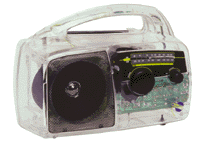
We're ready - we got the last propane camp stove from the Sunny's Outdoor store at the Potomac Run shopping center, and a little emergency radio that runs from batteries, solar cells, or a built-in, hand-crank generator. This electronic marvel is all in a package only slightly larger than a "Walkman" radio cassette. Not quite as "kwool" as the groovy see-thru packaging of the current models of BayGen radios, (Fred Boots brought his to a meeting last year) but it seems to pick up the local stations on AM and FM just fine!
New Software

Before Santa's visit to the old quarter-acre ranchero, I figured it was time to stuff the hard drive with some new software. Went to the BUY.COM website and ordered the professional upgrade version of Corel Office 2000 - this one includes Paradox 9, as well as the usual members of the WordPerfect Suite family. I placed my order on Saturday evening, 11/27, and it arrived via UPS ground (free shipping) on the following Thursday. Given all the commitments of this time of the year, it's too early for me to do a review of this package - and it's probably too big for even half a dozen professional reviewers to do a thorough job of it. I've only scratched the surface with the WordPerfect 9 application - the font review feature is great, and the AutoScroll feature avoids the frustration common to all Windows users as they try to move slowly from page to page.
As the Suite products have gotten bigger, the supplied printed documentation's gotten skimpier - a lot of folks found themselves tripping over the boxes of 8 - 10 manuals that used to come with Suite software. Now, all that's on CD as Adobe Acrobat files, which are searchable. Printed documentation is limited to a 405 page manual covering all the included applications (except Dragon Naturally Speaking), and about a 200 page manual of fonts, clipart, and web eye candy. For consideration on how many trees are saved - the WordPerfect manual on CD is 723 pages, Paradox is 532 pages, Quattro (spreadsheet) 812 pages - and there are lots more manuals!
I also loaded Quicken Deluxe 99. Yes, I know, this is last year's product. I bought it in a package with
Turbotax during the last tax season, and just hadn't found time to put it on my machine. I was also
reluctant to chance an installation that could install M$ Internet Exploder Explorer and might kidnap my
email and browser clients into a truly painful experience. Turns out I was able to deselect that feared
installation by choosing a "custom install" and daring Redmond's Wrath by unchecking Explorer. This
installation was further complicated by the need to import files for my personal financial records, for
which I've been using Quicken since 1990, and NCTCUG's financial records.
Over the years, I'd gotten my personal records up to Quicken version 8 for DOS. I'd tried a Windows version for personal records, and didn't like the check entry / register module - when I suffered a hard drive crash in August of '95, I never reloaded the Windows version of Quicken. The Quicken records for the club eventually moved to Quicken 4 for Windows, as Fred Boots and Joe Mazur took on the Treasurer's duties later in the 90's. I adopted that version when I took over the Treasurer's position from Joe two years ago, but still kept my personal records with the DOS 8 Quicken.
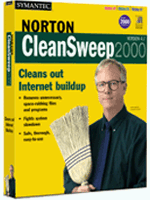
In short, it was time to "move up" and keep both records on a common version. In the course of moving the files into the new package (Quicken seems to change data formats with every version, requiring a simple updating step) I managed to mistake one of the files I moved, and got my personal account categories merged with those of the club. (Tear hair out for an hour!) Then I discovered that none of the WordPerfect 2000 suite programs would load. That lead to about two hours of Norton CleanSweep - backing up and deleting all the files from both WP2000 and Quicken 99. Then I loaded Quicken, imported both sets of financial data - correctly, into separate subdirectories this time! After verifying that Quicken worked, and I could separately access both financial record sets, I reloaded WP2000. Everything now worked.
I'm now trying to familiarize myself with all the features of Quicken 99. I can go out on the Internet to
the Intuit / Quicken web site, and directly download securities prices.  However, while the program will
allow you to get prices for every day for certain pre-selected periods (day, two days, week, two weeks,
month), it won't go and get them for "my" standard interval - every Friday. And, certain features won't
work with the Netscape browser - Quicken insists on using Explorer. Now to see if I can find work-arounds! I'll also try to get help from the Internet personal financial newsgroups that talk about
Quicken.
However, while the program will
allow you to get prices for every day for certain pre-selected periods (day, two days, week, two weeks,
month), it won't go and get them for "my" standard interval - every Friday. And, certain features won't
work with the Netscape browser - Quicken insists on using Explorer. Now to see if I can find work-arounds! I'll also try to get help from the Internet personal financial newsgroups that talk about
Quicken.
In searching for help when I was trying to resolve my problems with the two sets of financial records, I did notice a lot of negative comments on Quicken 2000, but I didn't spend enough time to figure out if this was because of buggy software, or equally frustrating, changes in the program so that folks couldn't find how to do things they been using successful in previous editions. With financial software, that a real problem - Intuit really risks alienating customers if they have difficulty finding features they've grown accustomed to - or that don't work in a new version.